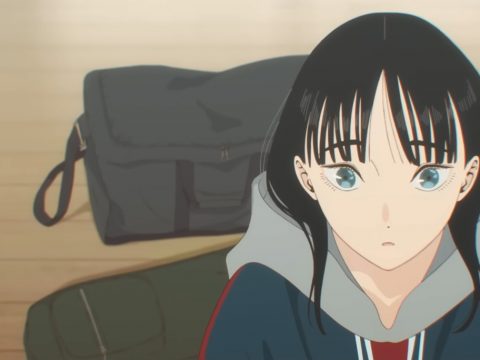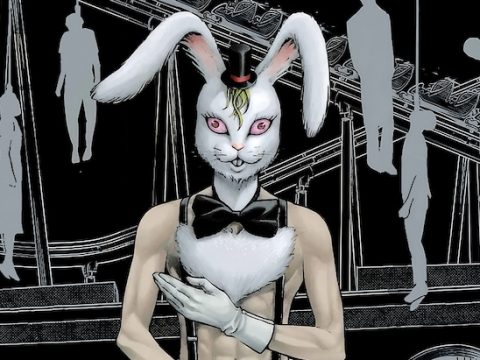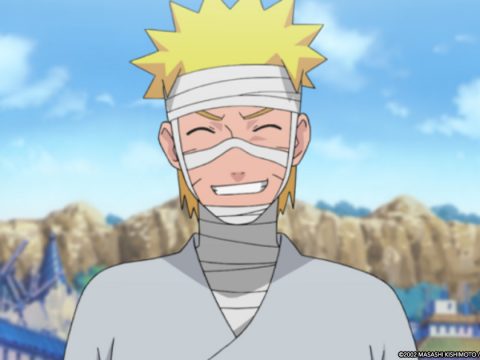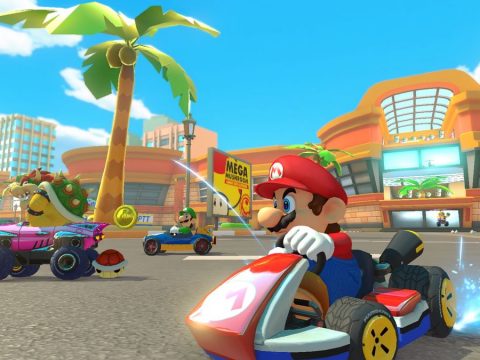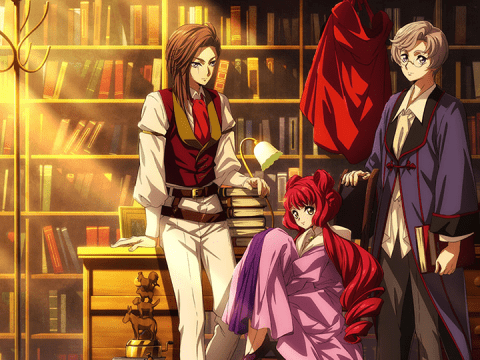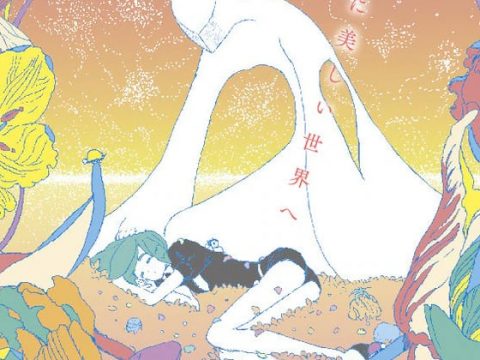Some manga artists are superstars who live in high towers guarded by thousands of editors and PR people. Others are a little more like most OEL comic artists: young artists drawing to make a living and because they like it.
Yuno Ogami is the first Japanese artist hired to create an original yaoi manga for the English-language market, DMP’s L’Etoile Solitaire, coming out in October 2007. Although she’s written dozens of short stories for Japanese magazines, it’s only her second graphic novel; her first was the untranslated Boy’s Love book Koi no Shoshinsha Mark (“Love’s Beginning Driver Mark”), released in Japan earlier this year.
Jason Thompson: How did you become a manga artist? Why did you do it?
Yuno Ogami: There are many ways to become a mangaka in Japan. Of course, the ideal is to bring your manuscript to a publisher, have it win a prize and debut, but even if you don’t win a prize, there is a system for editors to watch over new mangaka who have potential, and take care of them until they debut.
 In the year I spent doing this, I was scouted by editors from other publishers and I had more opportunities to draw manga. And before that, I worked as an assistant to a manga artist for three years. I’ve always wanted to tell stories, so in middle school and high school I wrote scripts for plays, and in college I shot films. I also liked to draw, and the reason I worked as an assistant was to refine my techniques as an illustrator. I wanted to do illustrations for the novels I would write. (laughs) But when I worked as an assistant, I discovered the charm of doing a story in manga form, and ever since then I’ve wanted to be a mangaka. So compared to some people, I chose to become a mangaka rather late.
In the year I spent doing this, I was scouted by editors from other publishers and I had more opportunities to draw manga. And before that, I worked as an assistant to a manga artist for three years. I’ve always wanted to tell stories, so in middle school and high school I wrote scripts for plays, and in college I shot films. I also liked to draw, and the reason I worked as an assistant was to refine my techniques as an illustrator. I wanted to do illustrations for the novels I would write. (laughs) But when I worked as an assistant, I discovered the charm of doing a story in manga form, and ever since then I’ve wanted to be a mangaka. So compared to some people, I chose to become a mangaka rather late.
�Did you study art in school, or are you self-taught?
In high school, I thought I’d go to an art school, and for a little while I attended art tutoring, but in the end I couldn’t keep it up. I learned the fundamentals of manga on the job as an assistant, and what I couldn’t learn at work I taught myself. Even today I’m still studying sketching and perspective.
What mangaka, BL (Boy’s Love) or otherwise, do you consider to be the greatest influences on your own work?
To tell the truth, I actually don’t read much BL so I won’t be influenced by other artists. As for non-BL manga, I’ve always liked Mamoru Nagano, Katsumi Michihara, and the illustrator Mutsumi Inomata. Lately I’ve been admiring Shu Okimoto, the artist in charge of the wine manga Kami no Shizuku (“Les Gouttes de Dieu,” or “The Drops of God,” from Morning magazine). Also, my master was a person named Satsuki Shibusawa, whose drawings are also wonderful. She has an official site so please check it out.
According to your blog, before you drew BL manga, you started out as a shojo manga artist. Can you tell us about this time in your life?
My original debut work was supposed to be a sexy manga aimed at men, but ever since then, I’ve used a different pen name and written shojo manga … or should I say, “young ladies'” manga, and “teen’s love” shojo manga with sex scenes. I’m all over the place. I came to draw BL because I was scouted along the way by a BL publisher. I’ve been jumping between a bunch of publishers, so I don’t have a collection of my shojo manga. My one book so far is BL.
How and why did you start drawing BL manga?
When I was an assistant, one of my friends was doing a dojinshi and asked me if I wanted to draw an original BL story. Back then, I drew it without understanding BL. I’m a little embarrassed to think about it now.

You have worked for several different BL magazines, including June, Pierce, and Boy’s Love. Did you and your editors tailor your work differently for the audiences of these different magazines?
Yes, of course. This magazine takes only modern stories, that magazine’s okay with fantasy, and so on. They’ll also request that a certain page count be taken up by sex scenes, so you have to follow guidelines on that too-though there are some publishers that don’t make these requests. Within the required number of pages and the requests on the editorial side, I create my work thinking about how I can express what I really want to say.
How do you balance your life as a mangaka with your nonwork life? How much time a week do you spend working?
I work 16 hours a day (more before deadlines), and once I start a job I don’t take a break for a week. After the work is finished, I take one or two days, clean the house, do meetings at the office, and go out to play. When I sit at my desk there’s a switch between nature and work. To mix things up, I’ll go on the Net, or because I love clothing, I rearrange my closet. My home is my workplace, so I can do household chores if I need a break.
 Do you socialize mostly with other mangaka? When you talk to your friends who aren’t mangaka, do you feel that being a mangaka is fundamentally different from other careers?
Do you socialize mostly with other mangaka? When you talk to your friends who aren’t mangaka, do you feel that being a mangaka is fundamentally different from other careers?
I have a lot of mangaka friends, but for some reason we never go out together. (laughs) More often I go out with my friends who aren’t mangaka. I feel I have a lot in common with people with creative jobs or interests. What I think is unique about mangaka, and also playwrights, directors, and actors, is that they all have to process everything, so you have to always keep your antennae up for some beneficial piece of information for your manga. What you see with your own eyes, what you believe, feel, think, know, all this is fodder for your manga.
Americans are not very familiar with the “assistant” system of manga production. How did you meet your assistants?
Japanese artists mainly find assistants through assistant recruitment bulletin boards. Some are introduced through friends. Some are on mixi (a Japanese social networking site, similar to MySpace).
Do you draw your own dojinshi?
Actually, I’m thinking of starting at J-Garden (a large BL dojinshi event) in September of this year, if I can get a space.
In your opinion, what is the appeal of BL manga that is not found in “ladies comics” or shojo romance manga?
I don’t really understand it either. Compared to people who are always searching for an answer to that question, my knowledge is insignificant. In Japan, the creators and readers of BL are mature, and there are many reasons for its appeal, so I can’t give a brief explanation. What I can say is, in male-female stuff, there’s a feeling of comfort in seeing the romance be fulfilled as it must be. But in a romance between men, because there are always obstacles, there’s the excitement of wondering, “What’s going to happen to them?” From the start they’re different.
In most BL, the seme is generally masculine and handsome and the uke is generally feminine and cute. When you design or sketch a character, do you always know beforehand which role the character plays? Do you start with the idea of seme or uke and work from there?
As I said earlier, I started drawing manga because I wanted to tell stories, so in my creation process the situation or story comes first. However, if I put too much of an emphasis on the story, the characters will move simply to fulfill the plot. If the characters move on their own inside me, the flow of the story may change somewhat.�
When you draw a uke, do you think of him as a character who the reader should find attractive, or a character who the reader should imagine themselves to be? Or is the uke just the uke?
First, his mentality should be that of a normal person. If the reader reads it, thinks “I’ve felt the same thing!”, follows the path of the character’s emotions, and is brought into the story, I’m satisfied. As to appearance … hmm, of course he should be beautiful. (laughs) I used to draw all my ukes with cute faces, but lately I’ve come to draw uke that are a little cooler looking too.

What do you feel is the most personal aspect of your manga? How would you describe the style of “Yuno Ogami’s manga”?
Even for very short works, I receive requests for comical stories and sexy stories, but fundamentally, I always make sure to explore serious themes. It’s okay to enjoy BL manga simply for what it is, but I also think it’s good to read more deeply, and think, “Hmm, is this what she means?” [I’ve also been exposed to many of those close readings.] I think it’s good to draw manga that can be enjoyed in many different ways.
If you were able to make a living drawing absolutely any kind of manga, without any guidance from an editor, what kind of manga would you draw? Does this situation sound appealing?
My original BL dojinshi scheduled to come out soon may be exactly what I want to draw on my own. (laughs) It uses the yakuza as a motif, though it may butt up against American censorship laws, so I may not have a chance to show it to you. (laughs) For me, less than genre, it’s “theme” that’s important, and “genre” is just one gateway to a theme. The theme of “the boy without a heart” is something I’ve been cooking up in my head for a while, and I wanted to draw it, so I decided to do it in a dojinshi. Of course, it is fun to draw what you like, but that will make you lose your objectivity, and I think that takes away from your duty [as an artist].
Yuno Ogami Websites:
https://marie.salin.net/~ring/
https://ogamiyuno.blog90.fc2.com

[Excerpted from the December 2007 issue of Otaku USA magazine.]


